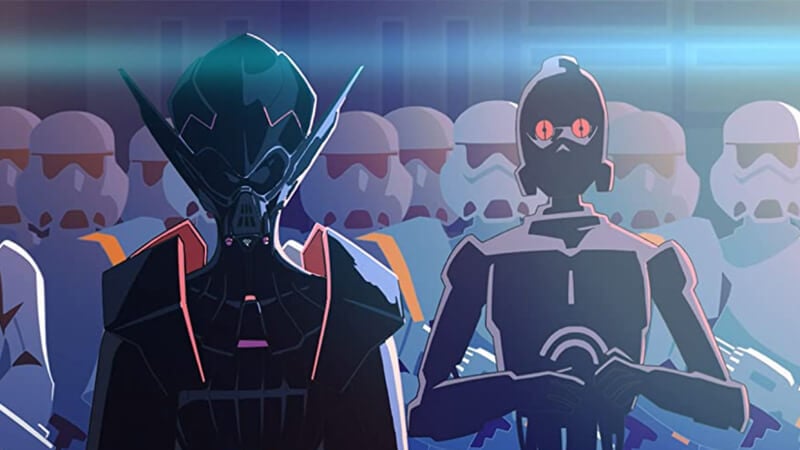Star Wars: Visions is a visionary experiment in animation. It is produced by Lucasfilm and is available on Disney+. In it, seven different studios tell nine different stories. Each has a unique style and voice. Kamikaze Douga, Studio Colorido, Geno Studio, Trigger, Kinema Citrus, Production IG, and Science SARU each bring forth their best efforts. The series reminds me of The Animatrix, and for good reason. We have an anthology of shorts from the best studios in animation. Each is full of imagination and tells a unique story in a familiar setting. Without a doubt, this anthology series is the best in Star Wars animation.
The Duel
The Duel was the episode that surprised me the most. The Jedi are my least favorite aspect of Star Wars. I know, I’m a heathen. Samurai tales are also pretty low on my interests as well. So, when these two concepts were wed and presented as the first episode…I should have hated it. I should have been immediately turned this off. But I didn’t. I got hooked. The cross-hatch film grain aspect with the feudal Japan backdrop suckered me in. The select use of color for the lightsabers, lasers, and lights was impactful and popped against the monochrome backdrop. The character design was top-notch, from the wandering ronin to the sith-lord and her lightsaber umbrella. The fight choreography was everything one could want in a sequence and makes the latest trilogy look pathetic by comparison. It’s a simple premise, but one that is executed masterfully. The Duel sets the tone for the remainder of the episodes in this animation anthology.
Tatooine Rhapsody
Tatooine Rhapsody screamed one thing to me more than anything else. From the animation to the musical influences, this episode reminded me of FLCL. This is high praise as FLCL is one of my favorite animes of all time. So, to get that feeling and have my favorite Star Wars character Boba Fett thrown in the mix? It’s perfect. The animation is fun and light-hearted without feeling too childish. It’s full of life and this is apparent with each action sequence. Again, the story is simple, but for a 15-minute episode, it has to be. But, like The Duel, the story is exceptionally well told. The only criticism is the distinct lack of jizz-wailers in a Star Wars musical-themed episode.
The Twins
The Twins was my most conflicting episode. I liked the concept of it and the animation and art style were amazing. The symmetry in each shot and the planning behind it was impressive. But the idea of two Force using twins smacked of Luke and Leia when it wasn’t them. It doesn’t help that both of them were wearing Darth Vader-inspired suits and had the equivalent of C-3PO and R2-D2 as companions. Throw in a random X-Wing and it’s just too on the nose. Plus, the idea of them making another form of a Death Star was tired. When it came to the action, most of it takes place outside in the vacuum of space without any protection and this completely broke my immersion. But, The Twins plays dangerously with the “rule of cool”. It’s immersion-breaking in a lot of ways, but it is a treat for the eyes.
The Village Bride
The Village Bride is the episode that stood out the most on its own. The world and characters they crafted could easily stand on their own, outside of the Star Wars universe. It reinforces my belief that the best Star Wars stories are the ones that are complete stories on their own that just so happen to take place in the Star Wars universe. When too much focus is put on fan service and Jedi, the story gets lost. It’s like they can’t see the forest for the trees. The animation is simple, bold, and beautiful. The story is a somber one, telling a classic tale of a village oppressed by an invading force. It’s a beautiful marriage of animation and Star Wars.
The Ninth Jedi
Have I told you how much I love the animation in this series? Should I tell you one more time? Each episode brings something different to the table and like a buffet, I’m loving the variety. This tale takes place long after the Jedi have been cast out from the light of the galaxy. In lore, each Jedi must craft their lightsaber as part of their training. Instead, we see a master saber-smith crafting lightsabers for a band of rogue Jedi that has been brought together. It’s a nice twist. The story of The Ninth Jedi is a little more complex than what we’ve seen up to this point. There is a main story and sub-story that are wed together about 2/3 of the way through. Throw in a twist that would make M. Night Shyamalan jealous and we’re five for five with this episode.
T0-B1
T0-B1 is clear that it’s not only honoring Star Wars but Astro Boy and Mega Man as well. It’s also the most childish of the episodes and probably my least favorite. That’s not to say it’s a bad episode. Far from it. The animation is top tier with a delightfully jovial sentiment. The watercolor aesthetic for the backgrounds is one of my favorites. It’s a unique look that makes it stand apart from others in terms of look and quality. The story is a simple one of a little boy android seeking to become something more. Rather than wanting to become a real boy, instead, T0-B1 wants to become a Jedi. The professor who built him plays the part of Geppetto, and it’s clear what secrets he harbors. It’s predictable but is like the stories parents read to their children. It’s familiar and told well. This is a perfect episode for little padawans to get into the larger universe of Star Wars.
The Elder
I’m conflicted about The Elder. It’s the most generic in terms of art style and the characters are kind of on the bland side as well. It’s episodes like this, that arguably have good animation, that make the rest of the animation in Star Wars: Visions stand out. When the worst is still better than a lot of other animation, that tells you something. Much like the animation itself, the story is kind of bland as well. It’s a good, quiet moment between a master and his apprentice. It’s one that I feel would be served better in a larger story. What little is here certainly lays the foundation for what could be a wonderful mystery. Unfortunately, it’s far too little meat on this meal.
Lop & Ocho
Lop & Ocho tells a classic story. Unfortunately, it is based on humanity’s tragic past. The themes are evocative of the British colonization of India and expansion into China. We see people on a planet full of natural resources that are being exploited by the Empire. A young girl is adopted into a well-to-do family that has ties to the Empire. This leads to a familial dispute as ties are tested. It spends a lot of time setting up a larger story that it ultimately can’t go anywhere with due to the short runtime. The animation and art style are evocative of anime from the late 90s, which only serves to bring me a sense of nostalgia. This is another episode that feels like it would be fine on its outside of the Star Wars universe and only suffers due to the forced connections.
Akakiri
Akakiri is an unusual spaghetti western. It’s the weirdest of the shorts in Star Wars: Visions. It’s a story of visions and destiny. A tale of love and the dark side. It’s also my least favorite because of how sloppy it feels. The animation feels loose and reminds me of Aeon Flux and Heavy Metal. Overall, this is the weakest entry in the series. It feels like watching a dream. Everything is just a little distorted and out of place.
In the end, Star Wars: Visions is a successful experiment. Without the constraints of adhering to a larger story or canon, the creators are allowed to truly go out and explore. The result is nine interesting stories that stand on their own. The animation is, for the most part, top-notch. It’s inspiring and makes me wish that Disney would let more creators have a shot at working within the Star Wars universe. If you’re a fan of animation and Star Wars, then definitely give Star Wars: Visions a watch.
[review]









